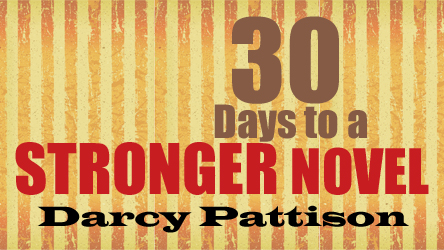30 Days to a Stronger Novel Online Video Course

Sign up for EARLY BIRD list for discounts
The book is now available for Pre-Order! It officially goes on sale on November 14.Do you speak for organization as a way to advertise your books? Maybe you do school visits, or talk to a Kiwanis club, or even do Keynote Speeches for various organizations as a way to supplement your writing income.
If so, I’ve got a great book for you.
TED Talks
I am inspired by the TED Talks. TED, or Technology, Entertainment and Design, a nonprofit organization, invites people to give “the speech of their lives” in 18 minutes or less. Each speech should focus on one “idea worth sharing.”
The video archive includes some of the best public speaking you’ll ever see.
If you want to give better speeches, it makes sense to study the TED talks.
 And that’s exactly what Jeremey Donovan has done in his book, HOW TO DELIVER A TED TALK: SECRETS OF THE WORLD’S MOST INSPIRING PRESENTATIONS. As you read this post on October 27, 2014, I’ll be at a Reading Recovery conference speaking about my work. The last time I went out, I bombed.
And that’s exactly what Jeremey Donovan has done in his book, HOW TO DELIVER A TED TALK: SECRETS OF THE WORLD’S MOST INSPIRING PRESENTATIONS. As you read this post on October 27, 2014, I’ll be at a Reading Recovery conference speaking about my work. The last time I went out, I bombed.
Now, I do a lot of speaking and it comes pretty easy for me. But last time, I really wasn’t prepared the way I should’ve been, and it showed. I vowed THAT would never happen again. In fact, that failure has spurred me to aspire to do better than ever before. Whatever level I was before, I’d like to up the game and improve.
Focus. When I taught freshman composition, the hardest thing was to get students to focus on something important enough, but manageable within the five pages of the assignment. Focus is difficult because we have so much we want to say. But not everything needs to go into THIS speech. TED talks ask you to find that one “idea worth spreading.”
It took me a long time to focus this speech! In some ways, the question is a philosophical one: what do you care about passionately? That’s what will connect with people.
Structure. Like any good writer or speechwriter, Donovan spends a lot of time on organization. There’s nothing particularly new or innovative in this section; however, his analysis of speech after speech is helpful, because you’ll see exactly how other TED talks were organized. He covers both inductive and deductive reasoning in detail.
Storytelling. The use of stories to enliven a speech is a time-tested technique. But Donovan explains the WHY and WHICH ONE. For me, the emphasis on a personal story was important. I am an ambivert, able to be extroverted when necessary, but in my everyday life, I’m an introvert. I don’t like sharing personal stories. And yet, for others to connect with you, it’s necessary. My new speech includes several new personal stories.
Powerpoint. Donovan says that about 60% of TED talks have no Powerpoint. Hurrah! It’s not my favorite method of giving information to a crowd. However–this time, I realized that I needed to do one. My normal approach would be to blow it off till the last minute–but that didn’t work last time and I was determined to do it right this time. I created a 55 slide pack.
Practice. Really? You want me to practice this 70 minute presentation? Yes. If I was doing a TED talk–with all the prestige of that organization, you can bet I would practice. I’m planning to do a run through a couple times this weekend. Realistically–one really good run-through is likely, but that’s better than the last time!
The benefits of taking the time to focus on the speech should be great. I know that I’ll relax more because I’m prepared. The connection with the audience should be much better than last time when I truly bombed. And who knows where it will go from there.
Slideshare From Jeremey Donovan
You should watch a 100 of these videos before you go out to do your next presentation! Here are some TED Talk Playlists to get you started.
As you read this, I’ll be about to speak. So send me the traditional on-stage blessing: Break a Leg!


